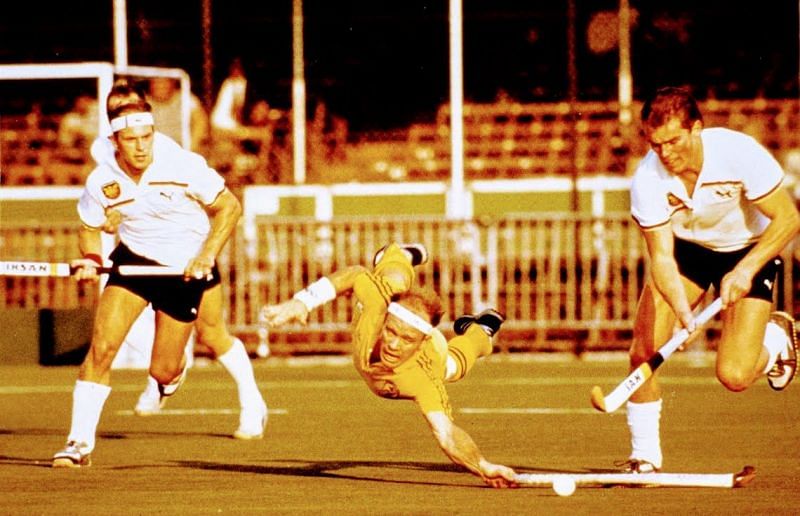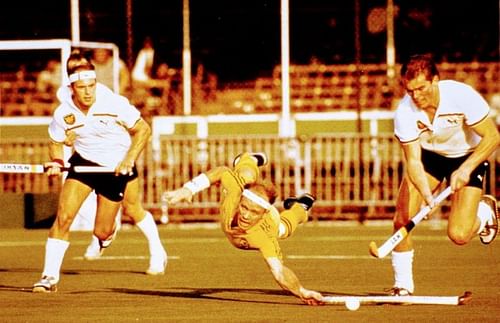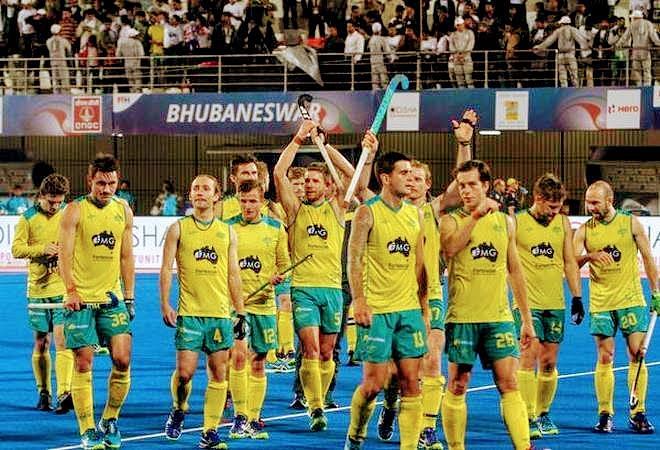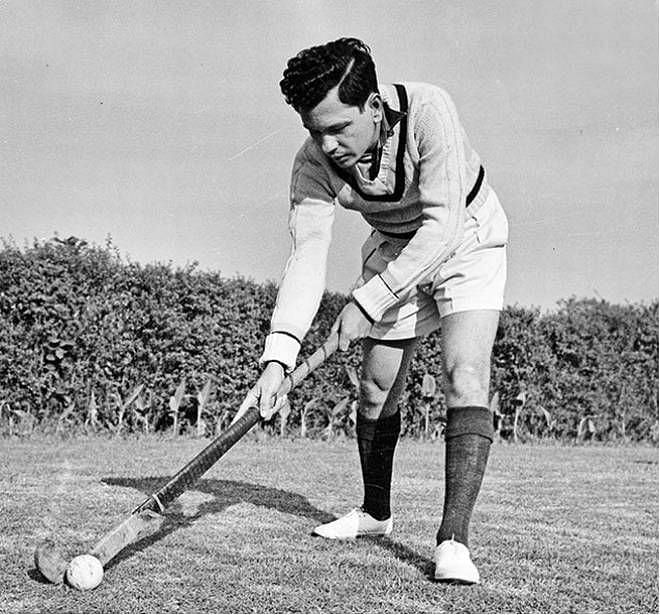
The indomitable Aussies, the Olympic hoodoo, and the Anglo-Indian connection

Australia has beaten India 4-2 in the Azlan Shah Cup sinking India's hopes of reaching the final.
Let's face it, India didn't play too badly.
Ramandeep Singh created some good moves, scoring twice. Nilam Xess made some great runs into the Australian half with amazing skill and Dipsan Tirkey gave an awesome display of how to tackle in the circle (and how to avoid a tackle) by shadowing the forwards with a grounded stick.
Both the Odisha lads exuded great confidence and played like veterans.
Yet, even a "good" performance against the might of an opposition like Australia is rarely good enough.
The Australians are in a league of their own and look likely to remain so in the foreseeable future.
Hockey lovers have been awestruck by the Aussie players who have been ruthlessly efficient and displayed such speed, skill, and finesse that leaves the opposition numbed and clueless.
The Australians have not just ended India's hopes in the Azlan Shah tournament. They have a history of doing so innumerable times, in several competitions over the years.
In fact, Australia is the team which ended India's domination of world hockey way back in 1970s.
Australia's domination and an enviable record
When Australia play against India, who will win is a foregone conclusion. While the statement might be a wee bit exaggerated, it is not too far off the mark either.
Following Australia's victory in the Azlan Shah Cup over a fledgling Indian outfit, the statistics tell a woeful tale (from an Indian perspective that is).
When Sardar Singh's young side took on the might of a full-strength squad captained by Mark Knowles, Australia registered their 81st win against India. India has prevailed over the kookaburras just 20 times in over 120 encounters.

Australia's domination over India, is also marked by the margins of their victories in big matches.
In the 2010 Commonwealth Games, Australia thrashed India 8-0 in the final in Delhi. Four years later, the Aussies met India again in the finals of the same competition, winning 4-0 in Glasgow.
Australia has a daunting and unmatched record and has never slipped below the top four since the 1980s which is a monumental achievement.
They have won the elite Champions Trophy a record number of 14 times (23 podium finishes), the Azlan Shah Cup a record nine times, Commonwealth Games five times in succession (1998, 2002, 2006, 2010, 2014), and the World Cup thrice (ten podium finishes).
Why then, has hockey's most dominant side in history won just a single Olympic gold medal?
Australia and the Olympic hoodoo
Australia had one of their best sides in the 1980s.
Legendary names like Ric Charlesworth, Terry Walsh, Michael Nobbs, and Colin Batch were part of the great side that won the Champions Trophy in 1983, 1984, and 1985.
Indians are no doubt familiar with Charlesworth, Walsh, and Nobbs as coaches as all of them have mentored the Indian team in the past while Colin Batch is the coach of the current Australian side.
Australia also won the World Cup in 1986 and the inaugural Azlan Shah Cup in 1983. One medal, however, eluded them. Inexplicably, the best team in the world had failed to win an Olympic gold.
In the 1984 Los Angeles Olympics, in spite of being one of the best teams in the competition, Australia could not win a medal.
The trend continued in the Seoul Olympics in 1988 and Australia ended up fourth on both occasions.
A silver in the 1992 Olympics was followed by bronze in 1996 and 2000. In the 2004 Athens Olympics, an Australian side coached by Barry Dancer finally broke what the hockey world called Australia's "Olympic hoodoo" beating the Netherlands 2-1.
The world's most successful hockey nation has only one Olympic gold to their credit, a fact which defies logic and confounds hockey lovers around the globe.
Over the years, Australia have not allowed changes in rules, surfaces, playing conditions, or new forces in world hockey to affect them. That is the true hallmark of a champion team.
Australia were unaffected by the transition to AstroTurf in the 1980s
Following the transition to the super-fast AstroTurf surface, meant to favor the European style of play, Asian powers like India and Pakistan were all at sea and failed to adapt to the change.
Australia, however, continued their dominance, totally unaffected by the change.
Traditionally, Australia played an attacking game using speed and skill to get numbers into the attack with four (and sometimes five) forwards.
In the past, Australia used the "pyramid" style or a 5-3-2-1 style with five forwards, three midfielders, two defenders and goalkeeper.
Of late, the Aussies use four forwards, but their style of play, in many ways, was similar to India's (and Pakistan's) in the old days who also used the pyramid style.
So, why did Australia adopt an Indian style of hockey when they started off?
The Anglo-Indian connection
Undivided India dominated world hockey since the Berlin Olympics in 1928 winning a staggering six gold medals right until the Melbourne Games in 1956.
India's supremacy was subsequently challenged by two countries both of which had players of Indian origin.
Firstly, by Pakistan as a result of partition. Second, by Australia, by virtue of the Anglo-Indian community who had migrated to Western Australia in large numbers following partition.
The hockey pedigree from one country, effectively, gave rise to two new hockey giants who ended India's invincible and unchallenged run.
The majority of Indian players who won gold for India from the 1920s to the 1950s were Anglo-Indian.
Broome Penniger and Leslie Hammond played alongside Dhyan Chand, the legend. Richard Allen was one of India's best goalkeepers of all time and a three-time Olympian.
When a large number of the Anglo-Indian community moved to Australia at the time of partition, they continued playing the sport they loved in a new land - and for a new country.
It was the Anglo-Indian community who sewed the seeds of hockey Down Under and slowly but steadily Australia dominated the sport.
Two Anglo-Indian captains in the 1960 Olympics

Leslie Claudius captained India in the 1960 Olympics in Rome. The great Leslie Claudius, a four-time Olympian and three-time gold medallist was an Anglo-Indian.
When India faced Australia, in the Rome Olympics, Leslie Claudius' opposite number was also of Anglo-Indian descent! Kevin Carton, an Anglo Indian was the captain of the Australian national team who lost 0-1 to India.
The famous Pearce brothers (who were Anglo-Indians) also played for Australia in the 1950s and 60s including Eric Robert Pearce, Cec Pearce, Mel Pearce, Gordon Pearce, and Julian Pearce.
The end of India's golden run
In the 1976 Olympics in Montreal, Australia won the silver medal and New Zealand gold. Pakistan managed a bronze medal but it was the beginning of the end of India's reign. The power center of hockey had shifted forever. (India won the gold in 1980, in Moscow as most hockey powers including Australia, Pakistan, West Germany, New Zealand and the Netherlands had boycotted the Games.)
India have never qualified for the semi-finals of an Olympic event or a World Cup ever since.
So, as the Australian hockey team embarks on their journey in 2018, setting their sights on the Azlan Shah, Commonwealth Games, and World Cup trophies, conquering one team after another, they do need to be thankful that historic events led to a movement of an Indian community to their shores.
It was the passion and skills of these very individuals which gave rise to a new superpower in the world of hockey.